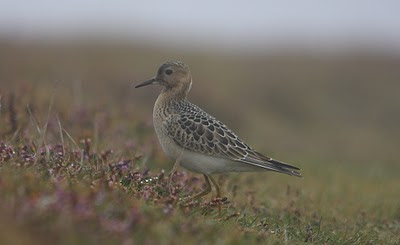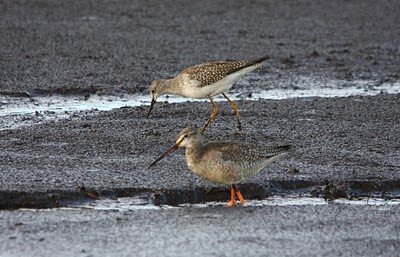Amazing.... the time has passed so quickly over the last couple of weeks I've barely had time to blink! I'd better fill you in on what has been happening down here in Cornwall..... it's been raining..... a lot. Fog too, not to mention force 6/7 westerly gales..... it's been brilliant!!!! (I know - birdwatchers are an odd sort!) The reason that this has been so good is because right now we're getting to tail end of the hurricanes and tropical storms hammering across from the Americas..... this in turn means that the Jet Stream is now parked straight over the top of the south-west, picking up migrant American passerines (that's smallish migratory birds like warblers, thrushes etc....) flinging them across the Atlantic and dumping them on our coasts.
Yes indeed it is a little sad that these little guys may never find their way home, but nature isn't as lovely as we all think it is..... for instance.... "aaahhhh, look at that cute baby bird".... Sparrowhawk comes in and nails it....... "oh."...... The real face of nature. It does, however, give us UK birders the chance to see some of their fantastic little birds and this year looks like it's going to be a good one.... I mean a real good one.... the south-west used to get tonnes of American bits and pieces in the 70's and 80's..... in fact 21 years ago today a Yellow-throated Vireo was found in Kenidjack Valley in Cornwall (the only one ever seen in Britain). Lately.... this has been not the case.... it can still turn up the odd bit, but nothing compared to what it used to..... until now.
This year, the list of American waders that have made it across the pond is staggering..... in fact it's been the best year that many can ever remember..... 10 species of them have made it.... Pectoral (the most common of the lot), Baird's, White-rumped, Solitary (mega rare), Spotted, Semipalmated, Least and Buff-breasted Sandpipers as well as Greater (mega mega rare) and Lesser Yellowlegs have all appeared and some in fantastic numbers..... Loop Head in Ireland had a peak of 15 Buff-breasted Sand with many other across the UK/Ireland and there were several Baird's (including the one I saw) and several White-rumped up and down the country. Since seeing the Baird's I've really been hoping to catch up with some of these vagrants as I've never really had the chance and I especially wanted to try and get them 'on film' as they are usually reasonably approachable. The first chance I had was during the fog down here, (which lasted the whole week..... that was fun trying to show people the Land's End wildlife at work.... it would have helped to see the sea!), when a pair of Buff-breasted Sandpipers were found in fields at the seaward end of the Nanjizal Valley where I go ringing by a local birder. A quick drive down after work proved fruitless, very hard locating the birds in the pea soup that was the fog, so I thought I'd try again early morning. Thankfully (after getting some better directions of John Swann....) I found them picking their way through the short grass, so after a bit of crawling and getting sopping wet I managed to get a couple of OK shots even though it was still foggy.
 |
| Buff-breasted Sandpiper (Tryngites subruficollis) |
I had seen these little crackers on the Scillies last year but not as well as this, it was just a pity that the weather wasn't great to get some better light in the pictures. This was really the start of the movement of American bits and I couldn't wait until the next one appeared so when a Semipalmated Sandpiper turned up at Chew Valley Lake in Somerset whilst I was back visiting Vicki, I couldn't resist going for it, after all, it would be a new bird for me too.
On arriving at the hide, the news was typical.... "You should have been here 5 minutes ago... it was right in front of the hide"...... Yeah, thanks for that..... a simple 'it's not showing at the moment' would have sufficed. Thankfully, there was a Pectoral Sandpiper in view along with an eclipse drake Garganey and drake Ferruginous Duck which entertained for a while (an hour in fact) before the sandpiper was relocated from the next hide. A quick shuffle and 10 minute later I was watching it.... a bit distant, but good enough to see the main ID points (apart from the semipalmations - the 'half-webs' in between the birds toes - which is where it gets its name from.) It then had a little fly around and I managed to grab a couple of record shots, it was just a dot though.
 | |
| Semipalmated Sandpiper (Calidris pusilla) on the right with a Dunlin (Calidris alpina) |
On the way back home from Chew the pager went and it was news of a Greater Yellowlegs in Wadebridge..... gutted, these don't turn up very often...... that was no more than an hour from where I was staying in Cornwall..... and I wasn't going home for another 4 days...... I had to hope it hung around.
Needless to say, the bird stayed for just a couple of days and disappeared...... a shame, but with the weather set to continue all through September there could always be another one...... please! After spending a bit in Somerset and having a day out at Thorpe Park (and almost losing my stomach going on 'Detonator'), I went back down to Cornwall with the intention of doing a bit of seawatching when I could. The next day I visited Pendeen for a few hours after work and it was cracking..... Fantastic views of 2 Long-tailed Skua (a new bird for me), 3 Sabine's Gull, 15+ Grey Phalarope, and numerous Great and Arctic Skua as well as a Ocean Sunfish.
I was then informed by John Swann that there was a Semipalmated Sandpiper and a Lesser Yellowlegs at Drift Reservoir, so I had my morning before-work plan sorted..... Both birds showed well, but again not close enough to get pics.... I'd have to go back another day..... so I did..... I went again a couple of days ago and the views I got were probably the best I've ever had of anything.
After phoning a mate of mine who's pretty new into photography and asking if he'd like to go down to have a go at getting some photos of the waders, we arranged to meet on the north side of the reservoir where the Semi-p had been hanging out. On arrival the bird was showing brilliantly for a group of 5-6 birders, no more than 20 metres away. I cracked of a few shots, but they weren't anywhere as good as I had got with the Baird's so I thought I'd attempt to get closer by lying on the shoreline a fair distance from the bird, but along it's path, so hopefully it would walk up to me. Most of the time this works pretty well until the bird sees you, about faces and runs away..... this wasn't the case with this little guy..... closer and closer he got, my shutter going nuts, until my lens whirred and I realised it was too close for it to focus. Instead of worrying about it, I watched the bird as it carried on pecking for invertebrates on the tide-line ending up no more than 2-3 foot away from me as it went past..... absolutely incredible. The reason he was so tame was probably because he'd never seen a human before so he had no fear whatsoever, it really has to be one of the most fantastic wildlife experiences I've ever had.
 |
| Semipalmated Sandpiper (Calidris pusilla) |
 | |
|
After that I knew it couldn't get any better, so I started off around the other side with James to have a look for the Lesser Yellowlegs. No sooner had I put one foot forward a couple of familiar faces came round the corner to look for the sandpiper.... Phil Woollen, Mark Payne and Dave Bradnum, all of whom I'd met on the pelagics from the Scillies the month previous. Dave had just come back from the Scillies after nipping across to see a Black and White Warbler and a few other bits on the islands that had turned up...... Phil and Mark had come down to do exactly the same thing the next day..... that got me thinking......... it would be a good bit of craic......
While I mulled it over, the guys had their own photo session with the sandpiper who continued to show well (Phil saying it was the most confiding one he'd ever seen.... and he's seen a few!).... until they were happy they'd seen it enough.... which is always a difficult one to judge..... I think we all feel the same way... you can't see things for long enough, but the sun was dipping and we wanted to go for the yellowlegs. We said goodbye to Dave as he'd seen it earlier and the four of us set off to go and search around the hide. When we got there the bird was showing pretty distantly, but was working it's way along the mud towards us, so again it was a bit of patience and hiding behind rocks until the legs got reasonably close (enough to take photos anyway)....... it was nice seeing it with a Spotted Redshank and a Common Redshank for comparison showing just how thin and elegant it was, it can be difficult to judge these things if you're only seeing the bird on its own.
 |
| Juvenile Lesser Yellowlegs (Tringa flavipes) |
 | |
|
 | |
|
 | |
|
After spending a while watching the bird wade around in the thick mud we talked about Scillies.... Phil and Mark were catching the plane first thing, so I decided to go across for a day with them, so it was back to base after some goodbyes, booking tickets (I booked to go by boat.... much cheaper and always the chance of seeing something else on the way).... and then to bed ready for what was going to be a bit of a mental day on the Scillies no doubt.
No comments:
Post a Comment